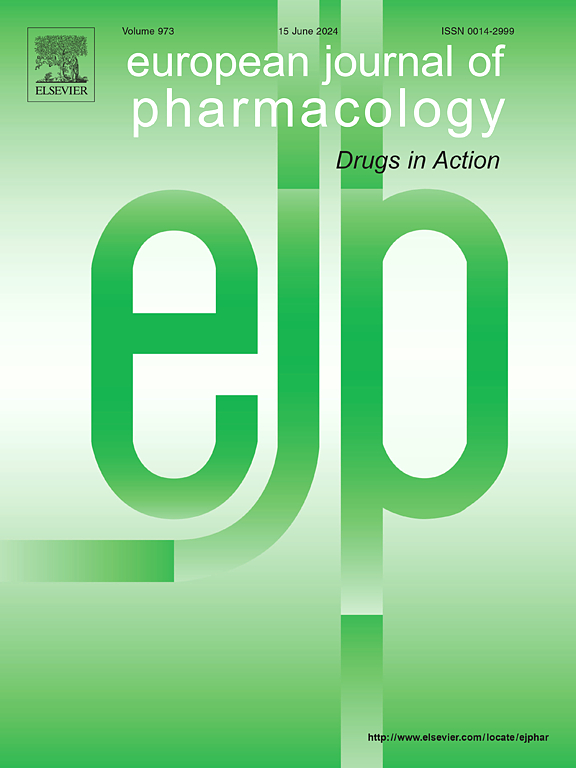The antidepressant potential of (2R,6R)-hydroxynorketamine: A detailed review of pre-clinical findings
IF 4.2
3区 医学
Q1 PHARMACOLOGY & PHARMACY
引用次数: 0
Abstract
Depression affects hundreds of millions globally, and in 2019, esketamine, an S-enantiomer of ketamine, was approved for treatment-resistant depression (TRD). While effective, esketamine carries risks, including abuse potential and adverse effects even at low doses. As a result, ketamine's metabolite, (2R,6R)-hydroxynorketamine ((2R,6R)-HNK), has garnered attention for its potential antidepressant effects without these drawbacks.
This selective review evaluates preclinical behavioral evidence for (2R,6R)-HNK's antidepressant properties, focusing on rodent studies that used established depression models. Results showed that (2R,6R)-HNK reduced behavioral despair, anhedonia, anxiety, and social avoidance in both stressed and non-stressed rodents. Antidepressant effects were observed at doses between 5 and 125 mg/kg, with rapid onset (30 min) and long-lasting effects (up to 21 days). However, some studies failed to demonstrate significant antidepressant effects at doses below 40 mg/kg, often in models with pre-induced depression. No significant adverse effects were reported, but data on side effects were limited.
In conclusion, (2R,6R)-HNK shows promise as a next-generation antidepressant. However, further research is needed to fully understand its long-term safety and mechanisms, and to determine its advantages over existing treatments like esketamine, particularly for TRD patients.
(2R,6R)-羟诺氯胺酮的抗抑郁潜能:临床前研究的详细回顾
抑郁症影响着全球数亿人,2019年,氯胺酮的s对映体艾氯胺酮被批准用于治疗难治性抑郁症(TRD)。虽然有效,但艾氯胺酮也有风险,包括滥用的可能性和即使在低剂量下也会产生不良反应。因此,氯胺酮的代谢物(2R,6R)-羟诺氯胺酮((2R,6R)-HNK)因其潜在的抗抑郁作用而引起了人们的关注。这篇选择性综述评估了(2R,6R)-HNK抗抑郁特性的临床前行为证据,重点是使用已建立的抑郁模型的啮齿动物研究。结果表明,(2R,6R)-HNK降低了应激和非应激小鼠的行为绝望、快感缺乏、焦虑和社交回避。剂量在5至125 mg/kg之间时观察到抗抑郁作用,起效迅速(30分钟),效果持久(长达21天)。然而,一些研究未能证明低于40 mg/kg的剂量有显著的抗抑郁作用,通常是在预先诱发抑郁症的模型中。没有明显的不良反应报告,但有关副作用的数据有限。总之,(2R,6R)-HNK有望成为下一代抗抑郁药。然而,需要进一步的研究来充分了解其长期安全性和机制,并确定其优于艾氯胺酮等现有治疗方法,特别是对TRD患者。
本文章由计算机程序翻译,如有差异,请以英文原文为准。
求助全文
约1分钟内获得全文
求助全文
来源期刊
CiteScore
9.00
自引率
0.00%
发文量
572
审稿时长
34 days
期刊介绍:
The European Journal of Pharmacology publishes research papers covering all aspects of experimental pharmacology with focus on the mechanism of action of structurally identified compounds affecting biological systems.
The scope includes:
Behavioural pharmacology
Neuropharmacology and analgesia
Cardiovascular pharmacology
Pulmonary, gastrointestinal and urogenital pharmacology
Endocrine pharmacology
Immunopharmacology and inflammation
Molecular and cellular pharmacology
Regenerative pharmacology
Biologicals and biotherapeutics
Translational pharmacology
Nutriceutical pharmacology.

 求助内容:
求助内容: 应助结果提醒方式:
应助结果提醒方式:


